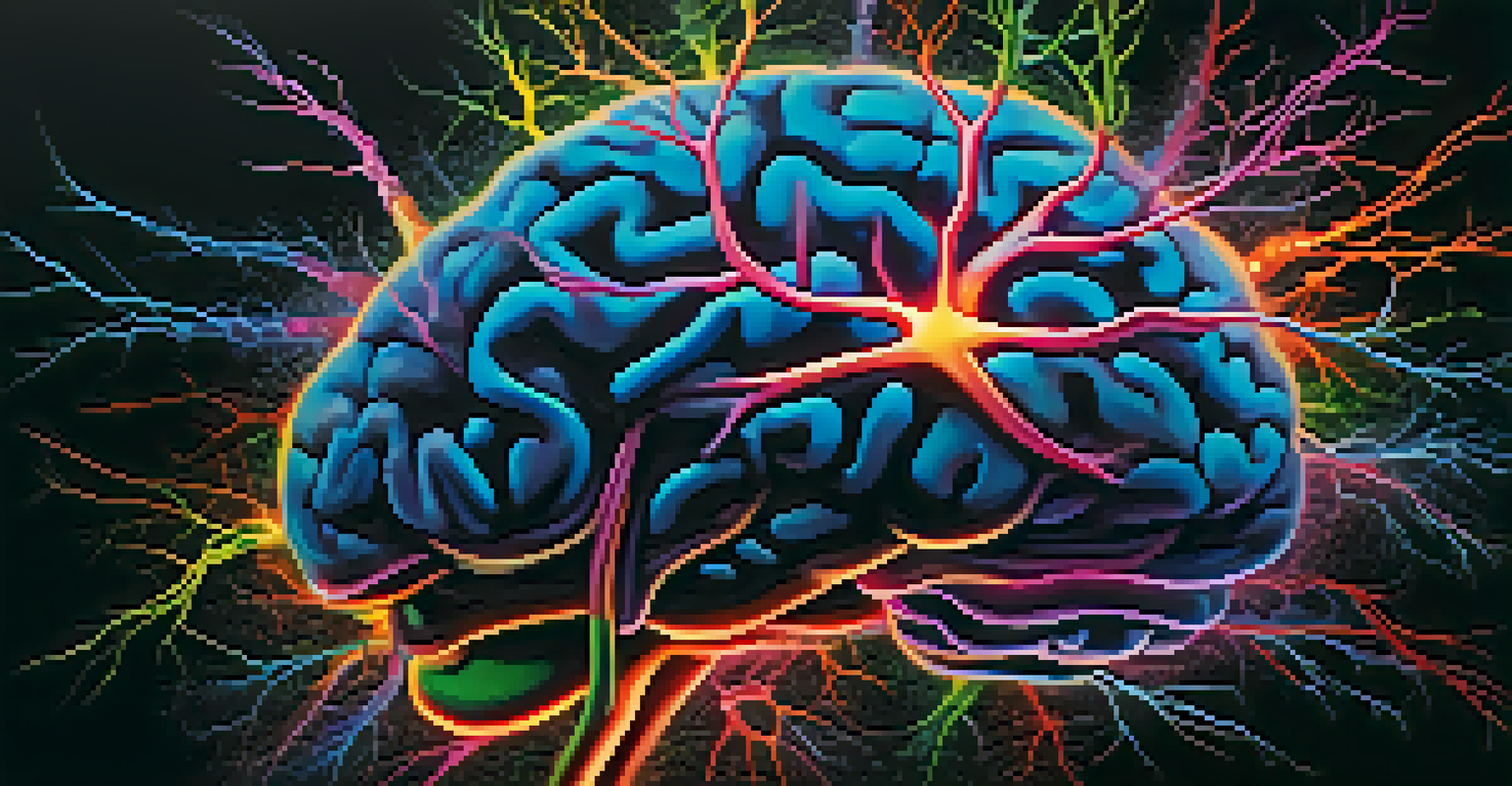Marijuana and Animal Models of Epilepsy: A Review

Understanding Epilepsy and Its Challenges
Epilepsy is a neurological disorder characterized by recurrent seizures, affecting millions worldwide. These seizures can vary in intensity and duration, making epilepsy a complex condition to study and treat. Current treatments, though effective for some, don't work for everyone, highlighting the need for innovative research approaches.
The future belongs to those who believe in the beauty of their dreams.
Researchers are constantly seeking new therapies, and animal models play a crucial role in this process. These models help scientists understand the underlying mechanisms of epilepsy and evaluate potential treatments before human trials. Utilizing animal models allows for a controlled environment to observe how different substances, including cannabis, affect seizure activity.
In recent years, there has been a growing interest in the therapeutic potential of marijuana for epilepsy management. With its complex chemical profile, including cannabinoids like CBD and THC, marijuana might offer promising avenues for treatment. Understanding how these compounds interact with epilepsy is a vital area of ongoing research.
The Role of Animal Models in Epilepsy Research
Animal models are essential for studying epilepsy because they can mimic the human condition more closely than cell cultures. Commonly used models include rodents, which exhibit seizure-like behavior that researchers can measure and analyze. These models help bridge the gap between laboratory research and clinical applications, providing insights into how different treatments may work.

Researchers often induce seizures in these animals to test new drugs or therapies, observing how they respond to various substances. The goal is to identify effective compounds that can reduce seizure frequency and severity. This methodical approach allows scientists to gather valuable data that can lead to breakthroughs in epilepsy treatment.
Epilepsy's Complexity and Treatment Needs
Epilepsy is a multifaceted neurological disorder that affects millions, necessitating ongoing research for more effective treatments.
Moreover, animal models enable researchers to study the long-term effects of treatments, something that is not always feasible in human trials due to ethical considerations. By understanding how marijuana and its compounds interact with the brain in these models, scientists can gain insights that may one day inform clinical practices for human patients.
Cannabinoids: What Are They and Their Importance?
Cannabinoids are chemical compounds found in cannabis plants, with the most well-known being THC (tetrahydrocannabinol) and CBD (cannabidiol). THC is primarily responsible for the psychoactive effects associated with marijuana, while CBD has gained attention for its potential therapeutic benefits without the high. Understanding these compounds is crucial for exploring their effects on epilepsy.
Research is creating new knowledge.
In recent years, CBD has emerged as a potential treatment option for epilepsy, particularly in drug-resistant cases. The FDA has even approved a CBD-based medication called Epidiolex for certain types of epilepsy, underscoring its therapeutic potential. This has led researchers to investigate how cannabinoids can modulate seizure activity in animal models.
By studying how cannabinoids affect neurotransmitter systems and neuronal excitability in animal models, scientists can uncover the mechanisms behind their anti-epileptic properties. This research could pave the way for new, cannabinoid-based therapies that offer hope for individuals living with epilepsy.
Current Research on Marijuana and Epilepsy
Research on marijuana's effects on epilepsy is expanding, with various studies exploring its potential benefits. Recent animal studies have shown that cannabinoids may reduce seizure frequency and improve overall brain health. These findings are encouraging, but they also highlight the need for further investigation to understand the full scope of marijuana's effects.
One notable study demonstrated that CBD reduced seizure activity in a specific animal model of epilepsy, providing a foundation for subsequent human trials. Such studies not only validate the potential of cannabinoids but also help identify optimal dosing regimens and delivery methods. This research is vital for translating findings from animal models to clinical settings.
Animal Models Aid Research Progress
Animal models are crucial for studying epilepsy, providing insights into treatment effects and long-term outcomes before human trials.
As more studies emerge, researchers are beginning to piece together how different cannabinoids interact with the brain's endocannabinoid system. This system plays a crucial role in regulating various physiological processes, including seizure activity. Understanding these interactions can lead to more targeted therapies and better outcomes for patients.
Challenges in Researching Marijuana for Epilepsy
Despite the promising findings surrounding marijuana and epilepsy, several challenges persist in this area of research. One major hurdle is the legal restrictions surrounding cannabis, which can limit access to high-quality, standardized products for research purposes. This complicates the ability to conduct comprehensive studies and draw reliable conclusions.
Additionally, the variability in cannabis strains and cannabinoid concentrations can lead to inconsistent results across studies. This variability makes it difficult for researchers to establish clear guidelines for effective dosages and treatment regimens. Ensuring that research adheres to strict protocols is essential for obtaining meaningful data.
Moreover, the stigma associated with marijuana use can hinder funding and support for research initiatives. As scientists work to overcome these barriers, it's crucial to engage in open discussions about the potential benefits and risks of marijuana as a therapeutic option for epilepsy.
Future Directions in Epilepsy Treatment Research
Looking ahead, the future of epilepsy treatment research is promising, particularly with the continued exploration of cannabinoids. As our understanding of the endocannabinoid system deepens, researchers are likely to uncover new therapeutic targets that could lead to more effective treatments. This could ultimately provide relief for individuals who have not responded to traditional medications.
Furthermore, advancements in technology and research methodologies are making it easier to conduct rigorous studies on the effects of marijuana in epilepsy. Techniques such as genetic engineering and imaging can offer deeper insights into how cannabinoids interact with brain cells, paving the way for innovative therapies. The integration of these technologies may enhance the precision of epilepsy treatment.
Cannabinoids Show Promise for Treatment
Research indicates that cannabinoids, particularly CBD, may offer therapeutic benefits for managing epilepsy, especially in drug-resistant cases.
Collaboration between researchers, healthcare providers, and patients will be essential in driving this research forward. By sharing knowledge and experiences, the epilepsy community can advocate for more comprehensive studies and push for the development of cannabinoid-based therapies that meet patients' needs.
Conclusion: The Promise of Marijuana in Epilepsy Treatment
In summary, the exploration of marijuana's role in treating epilepsy through animal models offers a promising avenue for future therapies. While challenges remain, the growing body of research highlights the potential for cannabinoids to improve seizure management. As scientists continue to investigate the complex interactions between cannabinoids and the brain, we may see more effective treatments emerge.
Animal models serve as a critical tool in this research, allowing for a better understanding of how marijuana can be utilized in clinical settings. With ongoing studies and increasing acceptance of cannabinoid therapies, there is hope for individuals living with epilepsy who struggle to find effective treatment options.

As we look to the future, a collaborative effort between researchers, healthcare professionals, and patients will be vital in unlocking the full potential of marijuana as a treatment for epilepsy. Embracing this research could lead to groundbreaking advancements in managing this challenging condition.